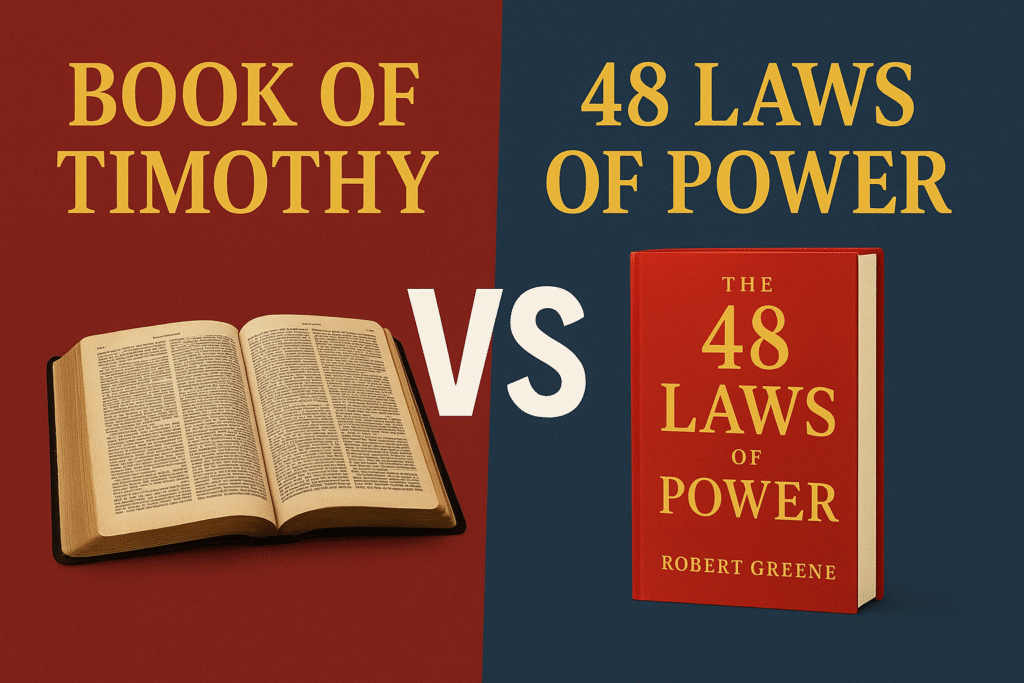When it comes to understanding leadership, influence, and power, two texts often stand at opposite ends of the spectrum: the Book of Timothy in the New Testament and Robert Greene’s 48 Laws of Power.
While Timothy emphasizes humility, faith, and servant leadership, Greene’s book takes a pragmatic—sometimes ruthless—approach to power in the real world. Comparing these two perspectives reveals not only their contrasts but also the unique lessons each offers for navigating life and leadership.
1. Source of Power
-
Timothy: Power comes from God, not self. “For God has not given us a spirit of fear, but of power, love, and self-discipline” (2 Timothy 1:7). Faith, integrity, and reliance on God are the true sources of strength.
-
48 Laws of Power: Power comes from perception, strategy, and control over others. Influence is gained through visibility, timing, and manipulation of human behavior.
✨ Lesson: Timothy roots power in spiritual truth, while Greene views it as a game of appearances.
2. Character and Integrity
-
Timothy: A leader must be blameless, faithful, sober-minded, and gentle (1 Timothy 3:1–13). Integrity is non-negotiable.
-
48 Laws of Power: Integrity is secondary to reputation. Appearances can be crafted, and even deceit may be necessary. For example, “Conceal your intentions” (Law 3) or “Always say less than necessary” (Law 4).
Lesson: Timothy emphasizes authenticity; Greene emphasizes performance.
3. Relationships with Others
-
Timothy: Leaders should guide with patience and love, avoiding quarrels (2 Timothy 2:24). Relationships are about service.
-
48 Laws of Power: Relationships are often transactional. Keep people dependent (Law 11), use selective honesty (Law 12), and guard your independence.
Lesson: Timothy views relationships as opportunities to serve; Greene sees them as leverage points.
4. Approach to Conflict
-
Timothy: Endure suffering, fight the good fight of faith, but remain gentle and steadfast (2 Timothy 4:7). Victory comes through endurance.
-
48 Laws of Power: Conflict must be decisive. Greene advises to “Crush your enemy totally” (Law 15) so they can’t return stronger.
Lesson: Timothy teaches perseverance through faith; Greene promotes domination to secure victory.
5. Pursuit of Goals
-
Timothy: Seek godliness, righteousness, and eternal life (1 Timothy 6:11–12). The aim is spiritual growth and eternal reward.
-
48 Laws of Power: Pursue influence, dominance, and survival in worldly systems. Success is measured by control and visibility.
Lesson: Timothy’s goals are eternal; Greene’s are temporal.
Conclusion: Two Lenses, One Reality
The Book of Timothy and The 48 Laws of Power represent two lenses for viewing leadership and influence. Timothy points us toward servant leadership, rooted in faith and integrity. Greene reveals the realities of worldly power—how people maneuver, manipulate, and protect themselves.
Together, they remind us that while it’s wise to understand worldly power dynamics, true leadership is grounded in humility, character, and service. As Jesus taught, “Whoever wants to be great among you must be your servant” (Matthew 20:26).

